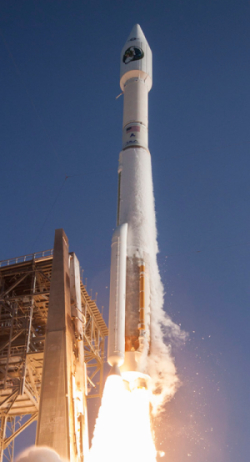Atlas 5 successfully launches U.S. surveillance satellite

The competition heats up: A ULA Atlas 5 rocket today successfully launched a National Reconnaissance Office (NRO) surveillance satellite, dubbed NROL-61.
The image on the right is courtesy of Orbital ATK. From the link above:
NROL-61, however, launched atop an Atlas V 421 rocket, a configuration that has not previously been used by the NRO. The spacecraft itself was encapsulated within an Extra-Extended Payload Fairing (XEPF) – at 14 metres (46 feet) in length the longest of three available four-metre (13-foot) diameter fairings – which has also never before been used for an NRO mission.
…The most likely explanation is that NROL-61 will be the first in a new generation of Quasar satellite; which would appear to be larger in both size and mass than its predecessors. Quasar, also known as the Satellite Data System, or SDS, is a constellation of communications satellites operated by the NRO to support its other intelligence-gathering activities; relaying data from other satellites to the ground in real-time, without having to wait for the intelligence-gathering satellites to pass over ground stations on friendly territory. If NROL-61 represents a new version of Quasar, it will be the fourth generation of the constellation.

The competition heats up: A ULA Atlas 5 rocket today successfully launched a National Reconnaissance Office (NRO) surveillance satellite, dubbed NROL-61.
The image on the right is courtesy of Orbital ATK. From the link above:
NROL-61, however, launched atop an Atlas V 421 rocket, a configuration that has not previously been used by the NRO. The spacecraft itself was encapsulated within an Extra-Extended Payload Fairing (XEPF) – at 14 metres (46 feet) in length the longest of three available four-metre (13-foot) diameter fairings – which has also never before been used for an NRO mission.
…The most likely explanation is that NROL-61 will be the first in a new generation of Quasar satellite; which would appear to be larger in both size and mass than its predecessors. Quasar, also known as the Satellite Data System, or SDS, is a constellation of communications satellites operated by the NRO to support its other intelligence-gathering activities; relaying data from other satellites to the ground in real-time, without having to wait for the intelligence-gathering satellites to pass over ground stations on friendly territory. If NROL-61 represents a new version of Quasar, it will be the fourth generation of the constellation.


